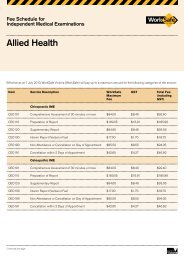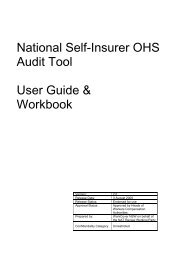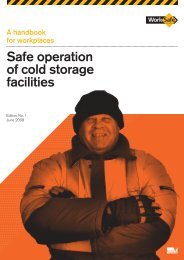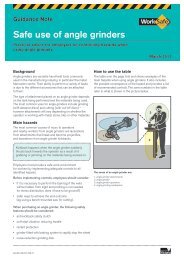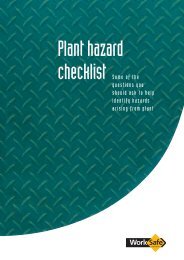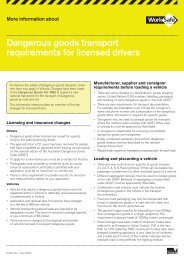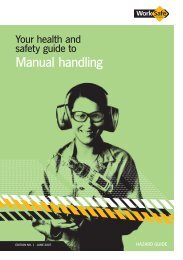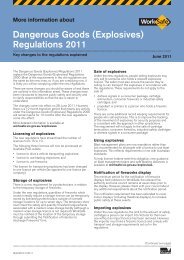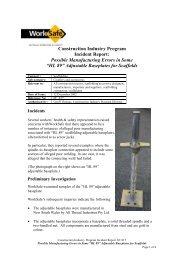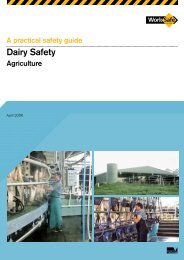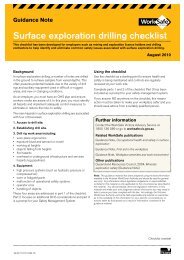Machinery and Equipment Safety - An Introduction - WorkSafe Victoria
Machinery and Equipment Safety - An Introduction - WorkSafe Victoria
Machinery and Equipment Safety - An Introduction - WorkSafe Victoria
You also want an ePaper? Increase the reach of your titles
YUMPU automatically turns print PDFs into web optimized ePapers that Google loves.
RISK CONTROL OF MACHINERY<br />
AND EQUIPMENT HAZARDS<br />
2.2 RISK CONTROL OF MECHANICAL HAZARDS<br />
Separation is a simple <strong>and</strong> effective machinery <strong>and</strong> equipment risk control.<br />
Separation may be achieved by distance, barrier or time.<br />
Fences, barriers, guards <strong>and</strong> interlocked gates<br />
separate people from the hazardous action<br />
of machinery <strong>and</strong> equipment.<br />
• Distance separation means a person cannot reach the hazard due to distance.<br />
• Barrier separation means an effective barrier or guard denies access <strong>and</strong><br />
controls ejection of parts, products or waste.<br />
• Time separation means at the time of access, the machinery or equipment<br />
is disabled.<br />
Examples include:<br />
• physical barriers <strong>and</strong> guards such as fences, screens or fixed panels of<br />
various materials<br />
• various forms of guarding <strong>and</strong> interlocking (as described in Australian St<strong>and</strong>ard<br />
AS 4024, part 1601 <strong>and</strong> part 1602, <strong>Safety</strong> of <strong>Machinery</strong>)<br />
• making the hazard inaccessible by reach (where the distance between a person<br />
<strong>and</strong> the hazard forms an effective barrier).<br />
Note: When considering the suitability of distance guarding, also consider the safe<br />
access requirements of maintenance people who gain access by ladder, scaffold<br />
or elevated work platform.<br />
Guarding<br />
A guard can perform several functions: it can deny bodily access, contain ejected<br />
parts, tools, off-cuts or swath, prevent emissions escaping or form part of a safe<br />
working platform.<br />
<strong>An</strong> old style power press incorporating a<br />
manual interlock <strong>and</strong> adjustable guarding.<br />
If the guard slides up, a connected metal<br />
bar separates the clutch mechanism <strong>and</strong><br />
the press will not activate.<br />
The guard can be adjusted to provide an<br />
opening by releasing retaining bolts on the<br />
guard face to allow individual panels to move.<br />
Adjustment must be performed by an<br />
experienced person to ensure the resulting<br />
opening only provides room necessary to<br />
incorporate the material being fed in <strong>and</strong><br />
prevents h<strong>and</strong>s or fingers intruding into the<br />
danger area.<br />
Guarding is commonly used with machinery <strong>and</strong> equipment to prevent access to:<br />
• rotating end drums of belt conveyors<br />
• moving augers of auger conveyors<br />
• rotating shafts<br />
• moving parts that do not require regular adjustment<br />
• machine transmissions, such as pulley <strong>and</strong> belt drives,<br />
chain drives, exposed drive gears<br />
• any dangerous moving parts, machines or equipment.<br />
Where access is not anticipated, a fixed guard can be permanently applied by<br />
bonding agent, welding or secured with one-way screws. If access is generally<br />
not required, a permanently fixed barrier is the preferred option.<br />
Where access to the hazard is infrequent, the installation of a fitted guard that<br />
can be removed by use of a tool may be an acceptable control, where the tool<br />
to remove the barrier or guard is not normally available to the operator.<br />
Adjustable guarding incorporates movable sections or panels of the guard <strong>and</strong><br />
allows for material or parts to be fed into the guarded area while still preventing<br />
bodily contact.<br />
WORKSAFE VICTORIA / MACHINERY AND EQUIPMENT SAFETY – AN INTRODUCTION 9




